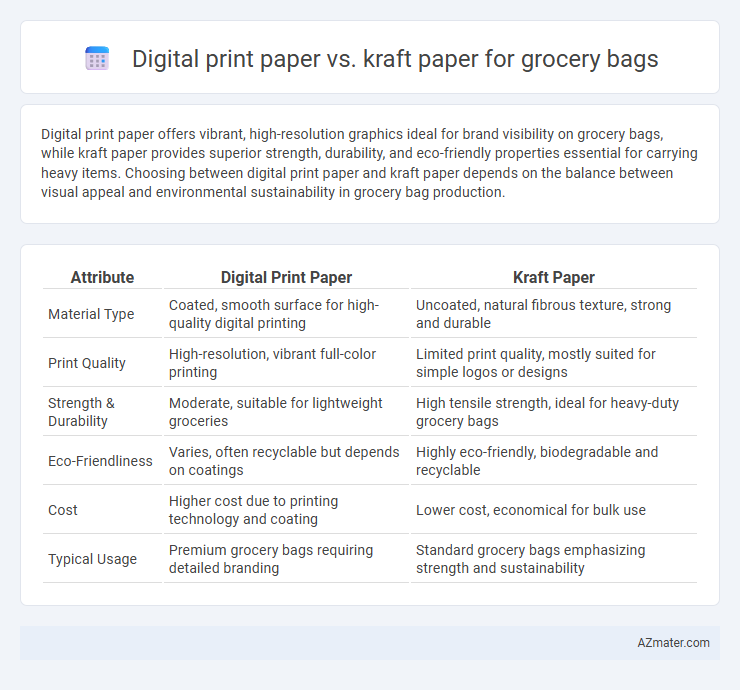Digital print paper offers vibrant, high-resolution graphics ideal for brand visibility on grocery bags, while kraft paper provides superior strength, durability, and eco-friendly properties essential for carrying heavy items. Choosing between digital print paper and kraft paper depends on the balance between visual appeal and environmental sustainability in grocery bag production.
Table of Comparison
| Attribute | Digital Print Paper | Kraft Paper |
|---|---|---|
| Material Type | Coated, smooth surface for high-quality digital printing | Uncoated, natural fibrous texture, strong and durable |
| Print Quality | High-resolution, vibrant full-color printing | Limited print quality, mostly suited for simple logos or designs |
| Strength & Durability | Moderate, suitable for lightweight groceries | High tensile strength, ideal for heavy-duty grocery bags |
| Eco-Friendliness | Varies, often recyclable but depends on coatings | Highly eco-friendly, biodegradable and recyclable |
| Cost | Higher cost due to printing technology and coating | Lower cost, economical for bulk use |
| Typical Usage | Premium grocery bags requiring detailed branding | Standard grocery bags emphasizing strength and sustainability |
Introduction to Grocery Bag Materials
Digital print paper and Kraft paper are two popular materials used for grocery bags, each offering distinct benefits. Digital print paper provides vibrant colors and detailed graphics, ideal for branding and promotional purposes, while Kraft paper is renowned for its strength, durability, and eco-friendliness, making it a preferred choice for heavy or bulky groceries. Selecting the right material depends on factors like print quality, environmental impact, and the bag's intended use in retail settings.
Overview of Digital Print Paper
Digital print paper for grocery bags offers vibrant, high-resolution color reproduction suitable for detailed branding and promotional graphics, enhancing shelf appeal and consumer engagement. It typically provides a smooth surface that supports various digital printing technologies such as inkjet and laser, ensuring sharp image quality and fast production turnaround. This paper type excels in customization flexibility, making it ideal for short runs and seasonal designs compared to the more rustic, natural look of kraft paper.
Features of Kraft Paper
Kraft paper used for grocery bags is renowned for its exceptional strength, durability, and tear resistance, making it ideal for carrying heavy items. Its natural, unbleached fibers provide an environmentally friendly and biodegradable option that supports sustainability efforts. Unlike digital print paper, Kraft paper offers superior moisture resistance and better load-bearing capacity, ensuring reliable performance during everyday grocery use.
Environmental Impact Comparison
Digital print paper for grocery bags often uses water-based or eco-friendly inks, enhancing recyclability and reducing chemical waste, whereas Kraft paper is typically unbleached and biodegradable, making it highly sustainable and compostable. Kraft paper production usually consumes less energy and releases fewer pollutants compared to digitally coated papers, contributing to a lower carbon footprint. Choosing Kraft paper supports circular economy principles through easier recycling and natural decomposition, while digital print paper offers customization but may require more complex waste management.
Print Quality and Customization
Digital print paper offers superior print quality for grocery bags with vibrant colors, fine details, and the ability to reproduce complex designs accurately, making it ideal for brand visibility and promotional purposes. Kraft paper provides a rustic, natural look but has limitations in print clarity and color range, typically supporting simpler, one or two-color prints suited for eco-friendly branding. Customization on digital print paper is highly flexible, enabling full-color, photo-quality prints and varying design elements, whereas kraft paper customization is more constrained due to its rough texture and absorbent surface.
Durability and Strength Analysis
Digital print paper and Kraft paper differ significantly in durability and strength for grocery bags. Kraft paper, made from unbleached wood fibers, offers superior tensile strength and resistance to tearing, making it ideal for carrying heavy or bulky groceries. Digital print paper, often coated for enhanced print quality, tends to be less robust and more prone to damage under weight stress, limiting its durability for repeated or heavy use.
Cost Considerations
Digital print paper for grocery bags offers vibrant, high-quality designs but generally comes at a higher cost due to advanced printing technology and specialized ink requirements. Kraft paper provides a more economical option with its natural kraft fiber composition, lower material expenses, and better suitability for bulk orders. Businesses must evaluate budget constraints, desired print quality, and order volume to determine the most cost-effective choice for their grocery bag packaging.
Branding and Aesthetic Appeal
Digital print paper offers vibrant, high-resolution graphics that enhance brand visibility and create a premium aesthetic for grocery bags, making logos and promotional messages more eye-catching. Kraft paper provides a natural, rustic look that appeals to eco-conscious consumers and conveys sustainability, but its limited color palette restricts detailed brand expression. Selecting digital print paper supports intricate, colorful branding strategies, while kraft paper emphasizes simplicity and environmental values in grocery bag design.
Consumer Preference Trends
Consumers increasingly favor digital print paper for grocery bags due to its vibrant, customizable designs that enhance brand visibility and appeal. Kraft paper remains popular for its eco-friendly qualities and natural aesthetic, attracting environmentally conscious shoppers. Recent trends show a growing demand for sustainable packaging solutions combining the visual impact of digital prints with the recyclability of kraft paper.
Conclusion: Choosing the Right Material
Digital print paper offers vibrant colors and detailed graphics ideal for brand visibility, while kraft paper provides superior strength and eco-friendliness, crucial for heavy or bulky grocery items. The choice depends on balancing aesthetic appeal with durability; digital print paper suits premium or promotional bags, whereas kraft paper excels in sustainability and load-bearing capacity. Grocery stores prioritizing environmental impact and robustness should prefer kraft paper, while those emphasizing design customization benefit from digital print paper.

Infographic: Digital print paper vs Kraft paper for Grocery bag
 azmater.com
azmater.com